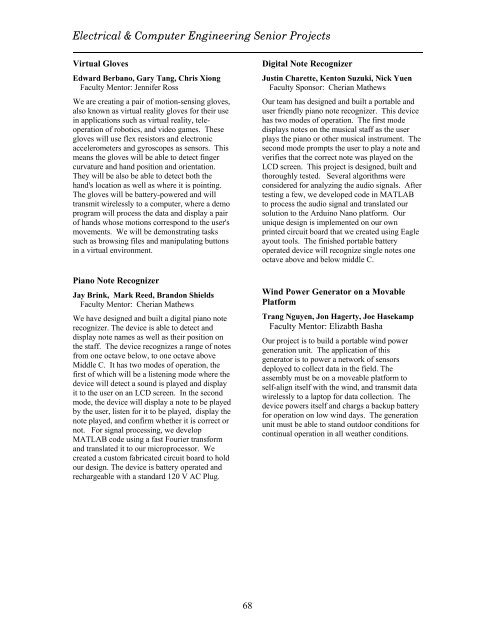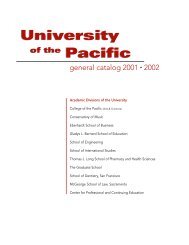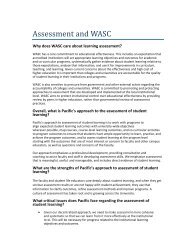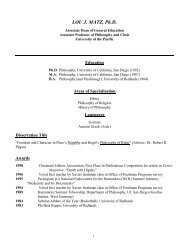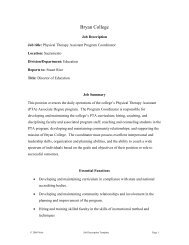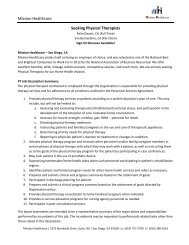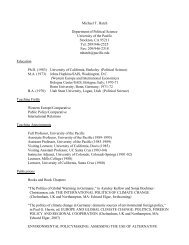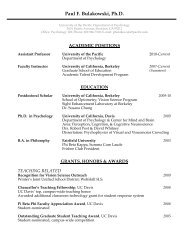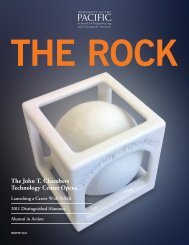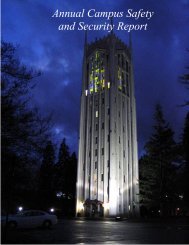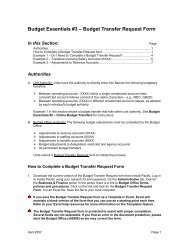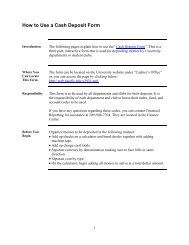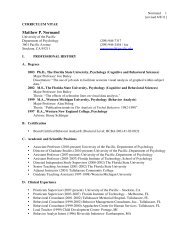purcc 2012 - University of the Pacific
purcc 2012 - University of the Pacific
purcc 2012 - University of the Pacific
Create successful ePaper yourself
Turn your PDF publications into a flip-book with our unique Google optimized e-Paper software.
Electrical & Computer Engineering Senior Projects<br />
Virtual Gloves<br />
Edward Berbano, Gary Tang, Chris Xiong<br />
Faculty Mentor: Jennifer Ross<br />
We are creating a pair <strong>of</strong> motion-sensing gloves,<br />
also known as virtual reality gloves for <strong>the</strong>ir use<br />
in applications such as virtual reality, teleoperation<br />
<strong>of</strong> robotics, and video games. These<br />
gloves will use flex resistors and electronic<br />
accelerometers and gyroscopes as sensors. This<br />
means <strong>the</strong> gloves will be able to detect finger<br />
curvature and hand position and orientation.<br />
They will be also be able to detect both <strong>the</strong><br />
hand's location as well as where it is pointing.<br />
The gloves will be battery-powered and will<br />
transmit wirelessly to a computer, where a demo<br />
program will process <strong>the</strong> data and display a pair<br />
<strong>of</strong> hands whose motions correspond to <strong>the</strong> user's<br />
movements. We will be demonstrating tasks<br />
such as browsing files and manipulating buttons<br />
in a virtual environment.<br />
Piano Note Recognizer<br />
Jay Brink, Mark Reed, Brandon Shields<br />
Faculty Mentor: Cherian Ma<strong>the</strong>ws<br />
We have designed and built a digital piano note<br />
recognizer. The device is able to detect and<br />
display note names as well as <strong>the</strong>ir position on<br />
<strong>the</strong> staff. The device recognizes a range <strong>of</strong> notes<br />
from one octave below, to one octave above<br />
Middle C. It has two modes <strong>of</strong> operation, <strong>the</strong><br />
first <strong>of</strong> which will be a listening mode where <strong>the</strong><br />
device will detect a sound is played and display<br />
it to <strong>the</strong> user on an LCD screen. In <strong>the</strong> second<br />
mode, <strong>the</strong> device will display a note to be played<br />
by <strong>the</strong> user, listen for it to be played, display <strong>the</strong><br />
note played, and confirm whe<strong>the</strong>r it is correct or<br />
not. For signal processing, we develop<br />
MATLAB code using a fast Fourier transform<br />
and translated it to our microprocessor. We<br />
created a custom fabricated circuit board to hold<br />
our design. The device is battery operated and<br />
rechargeable with a standard 120 V AC Plug.<br />
Digital Note Recognizer<br />
Justin Charette, Kenton Suzuki, Nick Yuen<br />
Faculty Sponsor: Cherian Ma<strong>the</strong>ws<br />
Our team has designed and built a portable and<br />
user friendly piano note recognizer. This device<br />
has two modes <strong>of</strong> operation. The first mode<br />
displays notes on <strong>the</strong> musical staff as <strong>the</strong> user<br />
plays <strong>the</strong> piano or o<strong>the</strong>r musical instrument. The<br />
second mode prompts <strong>the</strong> user to play a note and<br />
verifies that <strong>the</strong> correct note was played on <strong>the</strong><br />
LCD screen. This project is designed, built and<br />
thoroughly tested. Several algorithms were<br />
considered for analyzing <strong>the</strong> audio signals. After<br />
testing a few, we developed code in MATLAB<br />
to process <strong>the</strong> audio signal and translated our<br />
solution to <strong>the</strong> Arduino Nano platform. Our<br />
unique design is implemented on our own<br />
printed circuit board that we created using Eagle<br />
ayout tools. The finished portable battery<br />
operated device will recognize single notes one<br />
octave above and below middle C.<br />
Wind Power Generator on a Movable<br />
Platform<br />
Trang Nguyen, Jon Hagerty, Joe Hasekamp<br />
Faculty Mentor: Elizabth Basha<br />
Our project is to build a portable wind power<br />
generation unit. The application <strong>of</strong> this<br />
generator is to power a network <strong>of</strong> sensors<br />
deployed to collect data in <strong>the</strong> field. The<br />
assembly must be on a moveable platform to<br />
self-align itself with <strong>the</strong> wind, and transmit data<br />
wirelessly to a laptop for data collection. The<br />
device powers itself and chargs a backup battery<br />
for operation on low wind days. The generation<br />
unit must be able to stand outdoor conditions for<br />
continual operation in all wea<strong>the</strong>r conditions.<br />
68


